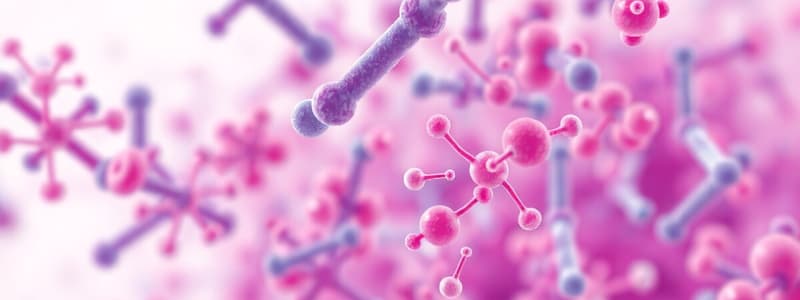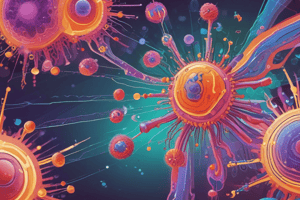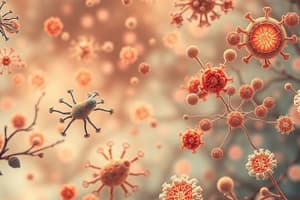Podcast
Questions and Answers
What type of antibodies are produced during a natural immune response or after immunization?
What type of antibodies are produced during a natural immune response or after immunization?
- Recombinant antibodies
- Synthetic antibodies
- Monoclonal antibodies
- Polyclonal antibodies (correct)
Which immunoglobulin class increases first after immunization?
Which immunoglobulin class increases first after immunization?
- IgG
- IgE
- IgM (correct)
- IgA
What technology is primarily used to produce monoclonal antibodies?
What technology is primarily used to produce monoclonal antibodies?
- Protein purification technology
- Hybridoma technology (correct)
- Gene sequencing technology
- Biosynthetic technology
What is the fusion of an immortal myeloma cell and an antibody producing B cell called?
What is the fusion of an immortal myeloma cell and an antibody producing B cell called?
What is the purpose of somatic hypermutation in B cell development?
What is the purpose of somatic hypermutation in B cell development?
Which of the following is NOT a property associated with antibodies?
Which of the following is NOT a property associated with antibodies?
Which type of antibody fragment is produced via recombinant technology?
Which type of antibody fragment is produced via recombinant technology?
What is one of the primary uses of antibodies in therapeutics?
What is one of the primary uses of antibodies in therapeutics?
Which immunoglobulin is predominant early in an immune response?
Which immunoglobulin is predominant early in an immune response?
What property distinguishes IgG from other immunoglobulins?
What property distinguishes IgG from other immunoglobulins?
Which of the following immunoglobulins is primarily found in seromucous secretions?
Which of the following immunoglobulins is primarily found in seromucous secretions?
What does the term 'valence' refer to in antigen-antibody interactions?
What does the term 'valence' refer to in antigen-antibody interactions?
Which immunoglobulin class has a known serum function focused on B cell activation?
Which immunoglobulin class has a known serum function focused on B cell activation?
What defines the 'idiotype' of an antibody?
What defines the 'idiotype' of an antibody?
Which immunoglobulin class is known to have multiple subclasses?
Which immunoglobulin class is known to have multiple subclasses?
What type of interactions do antibodies form with antigens?
What type of interactions do antibodies form with antigens?
What is the main role of IgE in the immune system?
What is the main role of IgE in the immune system?
What is the primary characteristic of antibodies classified under the isotype category?
What is the primary characteristic of antibodies classified under the isotype category?
What is the primary outcome of somatic hypermutation in B cells?
What is the primary outcome of somatic hypermutation in B cells?
Which of the following best describes class switching in antibodies?
Which of the following best describes class switching in antibodies?
What role do cytokines play in the process of class switching?
What role do cytokines play in the process of class switching?
Which factor is NOT directly involved in increasing the functional diversity of antibodies?
Which factor is NOT directly involved in increasing the functional diversity of antibodies?
In which of the following contexts are antibodies NOT typically used?
In which of the following contexts are antibodies NOT typically used?
What is the primary function of antibodies?
What is the primary function of antibodies?
Which characteristic is NOT required for a substance to be considered immunogenic?
Which characteristic is NOT required for a substance to be considered immunogenic?
What are haptens?
What are haptens?
What do we call the part of an antibody that recognizes and binds to an antigen?
What do we call the part of an antibody that recognizes and binds to an antigen?
How are antibodies structurally composed?
How are antibodies structurally composed?
Which of the following statements is true regarding antigens and immunogens?
Which of the following statements is true regarding antigens and immunogens?
What happens to an antibody molecule during proteolytic cleavage?
What happens to an antibody molecule during proteolytic cleavage?
Which region of an antibody varies among different antibody molecules?
Which region of an antibody varies among different antibody molecules?
What occurs during the primary immune response?
What occurs during the primary immune response?
What does 'seroconversion' indicate in the context of an infection?
What does 'seroconversion' indicate in the context of an infection?
Which mechanism is responsible for the diversity of the antibody repertoire?
Which mechanism is responsible for the diversity of the antibody repertoire?
What is the role of V(D)J recombination in antibody development?
What is the role of V(D)J recombination in antibody development?
During which phase does somatic hypermutation occur?
During which phase does somatic hypermutation occur?
What characterizes the secondary immune response compared to the primary response?
What characterizes the secondary immune response compared to the primary response?
What is the first detectable sign of an immune response to an infecting agent in the blood?
What is the first detectable sign of an immune response to an infecting agent in the blood?
What best describes the process of somatic recombination?
What best describes the process of somatic recombination?
Flashcards are hidden until you start studying
Study Notes
Antibodies
- Antibodies are proteins that bind to specific substances called antigens.
- Antibodies are also known as immunoglobulins (Igs).
- Antibodies are secreted by differentiated B cells called plasma cells.
Antigens and Immunogens
- Antigens can bind to antibodies or be recognized by T-cell receptors.
- Immunogens can elicit an adaptive immune response.
- All antigens have the potential to elicit specific antibodies, but some need to be combined with an immunogen.
- All immunogens are antigens, but not all antigens are immunogenic.
Requirements for Immunogenicity
- Substances must possess the following characteristics to be immunogenic:
- Foreignness
- High Molecular Weight
- Chemical Complexity
- Degradability
Haptens
- Small organic molecules that cannot trigger immune responses on their own.
- Can trigger an immune response when attached to a protein carrier.
Antigen, Epitope, and Paratope
- Epitope is a specific region on an antigen that binds to an antibody.
- Antibodies are specific to epitopes and not the entire antigen.
- Paratope is the region on an antibody that recognizes and binds to the epitope.
Antibody Structure and Fragments
- Antibodies are made of two heavy chains and two light chains.
- The variable region of the antibody determines its antigen specificity.
- Proteolytic enzymes can cleave antibodies into three fragments:
- Two identical Fab fragments (antigen-binding)
- One Fc fragment (crystallisable)
Immunoglobulins
- Five different classes of immunoglobulins:
- IgM
- IgD -IgG (4 subclasses - IgG1-4)
- IgA (2 subclasses - IgA 1,2)
- IgE
- Different antibody isotypes activate diverse effector systems.
- Selected properties of human antibodies can be found in Table 4-1 of Helbert's Immunology for Medical Students 3rd edition.
Selected Features of Human Antibodies
- IgM:
- Predominant in early immune responses.
- Has 10 potential antigen-binding sites.
- Efficient at agglutinating bacteria and activating complement.
- IgD:
- Involved in B-cell activation.
- Serum function unknown.
- IgG:
- Most prevalent in serum.
- Able to cross the placenta to protect newborns.
- IgE:
- Evolved to combat parasitic infections.
- Also involved in allergic reactions.
- IgA:
- Found in serum and seromucous secretions
- IgA1 is primarily found in serum.
- IgA2 is predominantly found in seromucous secretions like saliva, colostrum, tracheobronchial, and genitourinary secretions.
Antibody Variations
- Isotype: Differences in the constant region of the heavy chain, creating the different antibody classes.
- Allotype: Variations between individuals due to minor sequence differences in the heavy or light chains of antibodies.
- Idiotype: Variations in the antigen-binding region of different antibodies.
Antigen-Antibody Interactions
- Affinity: Strength of the interaction between a single antigen-binding site (paratope) and its epitope.
- Valence: Number of molecules an antigen or antibody can bind simultaneously.
- Avidity: Strength with which a multivalent antibody binds to a multivalent antigen.
- Antibodies form multiple non-covalent bonds with antigens like:
- Hydrogen bonds
- Electrostatic bonds
- Van der Waals forces
- Hydrophobic forces
- Cation-pi interactions
Specificity, Cross-reactivity, and Non-reactivity
- Reactions can exhibit high specificity.
- Reactions can be cross-reactive, binding to structurally related yet different antigens.
Immune Response and Secretion of Antibodies
- Seroconversion: Phase where antibodies against an infectious agent become detectable in the blood.
- Primary response: First exposure to an antigen. Slow, weak, and short-lived with low antibody levels.
- Secondary response: Second exposure to an antigen. Faster, stronger, and longer-lasting with higher antibody levels.
Antigens Activate Specific Clones of Lymphocytes
- The clonal selection hypothesis explains how specific lymphocytes are activated by antigens.
Postulates of the Clonal Selection Hypothesis
- Each lymphocyte bears a unique receptor.
- Lymphocytes with receptors that bind to antigens are selectively activated.
- Activated lymphocytes proliferate and produce more cells with the same specificity.
- Lymphocytes differentiate to become effector cells and memory cells.
Development of the Antibody Repertoire by Gene Recombination
- The immune system creates billions of antibodies from a limited number of genes.
- The diversity of the antibody repertoire is generated through:
- Somatic recombination: Rearrangement of DNA segments during B-cell development.
- Somatic hypermutation: Random mutations in the V region, altering antibody affinity.
- Class switching: Changes in the C region of the heavy chain, altering antibody function.
V(D)J Recombination Responsible for Initial Antibody Repertoire
- Somatic recombination rearranges segments of genomic DNA within immunoglobulin during B-cell development, independent of antigen exposure.
- The variable region of an immunoglobulin heavy and light chain is encoded by multiple gene segments:
- Heavy chain: Three segments.
- Light chain: Two segments.
Secondary Diversification of the Antibody Repertoire - Somatic Hypermutation
- Somatic hypermutation occurs in activated B cells, randomly mutating the V region and diversifying the antibody repertoire.
- It occurs simultaneously with class switching and both processes involve the enzyme Activation Induced Cytidine Deaminase (AID).
Somatic Hypermutation Enables Affinity Maturation
- Affinity maturation is the increased affinity for an antigen caused by somatic hypermutation.
- B-cell receptors with higher affinity for antigens are selected during the immune response.
Secondary Diversification of the Antibody Repertoire - Class Switching
- Class switching alters the C region of the heavy chain, enhancing antibody functional diversity while maintaining antigen specificity.
- Cytokines and T cells have a significant role in class switching.
- Isotype switching is heavily influenced by tissue environment due to different cytokine release by T cells in different areas.
Use of Antibodies as Diagnostic, Therapeutic, and Research Tools
- Antibodies are remarkably useful due to their high specificity and selectivity:
- Diagnostics: Detection of infections, measurement of biological markers, identification of allergies.
- Therapeutics: Treatment of cancer, infectious diseases, and autoimmune diseases.
- Research: Immunohistochemistry, Western blots, Flow cytometry.
Production of Polyclonal Antibodies
- Polyclonal antibodies are generated in natural immune responses or after immunization.
Blood Antibody Levels After Immunization
- IgM levels increase first after immunization.
- IgG levels increase with repeated immunizations.
Preparation of Monoclonal Antibodies
- Monoclonal antibodies are produced in unlimited quantities using:
- Hybridoma technology: Fusion of an immortal myeloma cell with an antibody-producing B cell.
- Recombinant technology: Synthetic antibody or antibody fragment produced by recombinant DNA technology.
Learning Objectives
- Describe the basic structure of antibodies.
- Understand the functions and properties of antibodies.
- Define: antibody, antigen, epitope, paratope, immunogen, hapten, affinity, avidity, valency, idiotype, isotype, and allotype.
- Discuss antigen-antibody interactions.
- Discuss the generation of the antibody repertoire.
- Discuss the use of antibodies in therapeutics and diagnostics.
- Discuss the preparation of monoclonal antibodies.
Required Reading
- Antibodies - Chapter 10 - 9th Edition (omit section on Fc receptors and antibody engineering).
- B cell development and the antibody response - Chapter 9 - 9th Edition (read section on somatic hypermutation and class switch recombination).
Additional Reading
- Janeway Immunobiology 9th Edition - Chapter 4 - Antigen Recognition by B and T Cell Receptors.
- Helbert - Immunology for medical students 3rd edition - Chapters 4, 5, and 6.
Studying That Suits You
Use AI to generate personalized quizzes and flashcards to suit your learning preferences.




